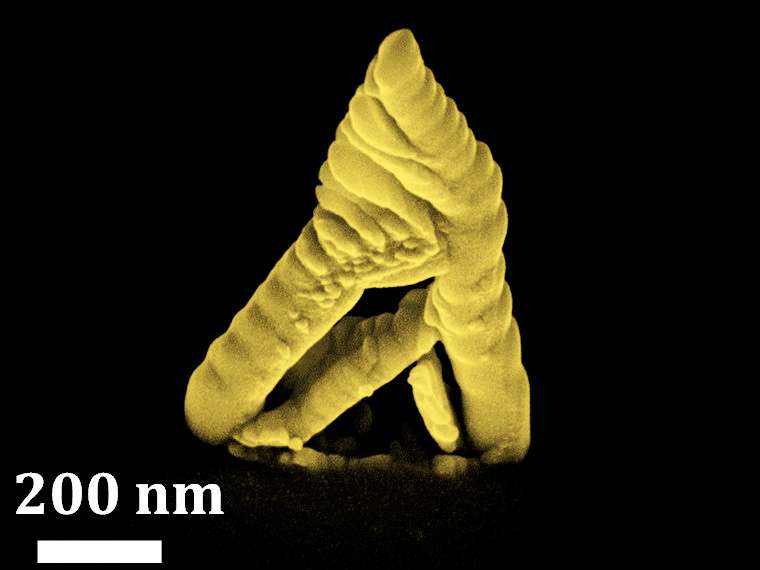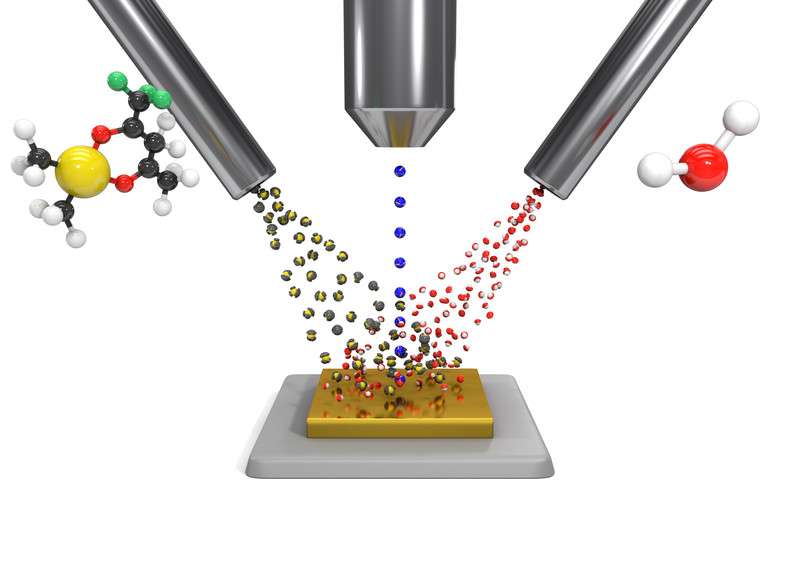Researchers create nanostructures made of pure gold

It is the Philosopher's Stone of Nanotechnology: using a technological trick, scientists at TU Wien (Vienna) have succeeded in creating nanostructures made of pure gold.
The idea is reminiscent of the ancient alchemists' attempts to create gold from worthless substances: Researchers from TU Wien (Vienna) have discovered a novel way to fabricate pure gold nanostructures using an additive direct-write lithography technique. An electron beam is used to turn an auriferous organic compound into pure gold. This new technique can now be used to create nanostructures, which are needed for many applications in electronics and sensor technology. Just like with a 3D-printer on the nanoscale, almost arbitrary shapes can be created.
The long search for the right production process
"Gold is not only a noble metal of exceptional beauty, but also a highly desired material for functional nanostructures", says Professor Heinz Wanzenböck from TU Wien. Especially patterned gold nanostructures are key enabling structures in plasmonic devices, for biosensors with immobilized antibodies and as electrical contacts. For decades the fabrication of pure gold nanostructures on non-planar surfaces as well as of 3-dimensional gold nanostructures has been the bottleneck. Up to now, only 2-dimensional gold nanostructures on planar surfaces were achievable by resist based lithography.

The new technology, developed at TU Wien, can now solve this problem. The principle is the local decomposition of a metalorganic precursor by the focused electron beam of an electron microscope. With extremely high precision, the electron beam can decompose the organic compound at exactly the right position, leaving behind a 3D-trail of solid gold.
The final obstacle was getting the material purity right, as the electron-induced decomposition of metalorganic precursors has typically yielded metals with high carbon contaminations. This last bottleneck on the road to custom-designed, pure gold nanostructures has now been overcome as described in the work on "Highly conductive and pure gold nanostructures grown by electron beam induced deposition" published in Scientific Reports.
While conventional gold deposition usually contains about 70 atomic % carbon and only 30 atomic % gold, the new approach developed by a research group lead by Dr. Heinz Wanzenboeck at TU Wien has allowed to fabricate pure gold structures by in-situ addition of an oxidizing agent during the gold deposition. "The whole community has been working hard for the last 10 years to directly deposit pure gold nanostructures", says Heinz Wanzenböck. At last, the group's expertise in engineering and chemical reactions paid off and direct deposition of pure gold was successful. "It's a bit like discovering the legendary philosopher's stone that turns common, ignoble material into gold" joked Wanzenboeck.
This deposited pure gold structure exhibits extremely low resistivity near that of bulk gold. Generally, a FEBID gold structure has a resistivity around 1-Ohm-cm which is about 1 million times worse than the resistivity of purest bulk gold. However, this specially enhanced FEBID process produces a resistivity of 8.8 micro-Ohm-cm which is only a factor 4 away from the bulk resistivity of purest gold (2.4 micro-Ohm-cm).
The authors of the paper Dr. Mostafa Moonir Shawrav and Dipl.Ing. Philipp Taus stated, "This highly conductive and pure gold structure will open a new door for novel nanoelectronic devices. For example, it will be easier to produce pure gold structures for nanoantennas and biomolecule immobilization which will change our everyday life". Dr. Shawrav added "it is remarkable how a regular SEM (Scanning Electron Microscope) nowadays can deposit nanostructures compared to 20 years back when it was only a characterization device". And with pure gold direct deposition available now, he expects nanodevices to be deposited directly and utilized in many different applications for technological revolution. Concluding, this work is a giant leap forward for 3D nano-printing of gold structures which will be the core part of nanoplasmonics and bioelectronics devices.
More information: Mostafa M. Shawrav et al. Highly conductive and pure gold nanostructures grown by electron beam induced deposition, Scientific Reports (2016). DOI: 10.1038/srep34003
Journal information: Scientific Reports
Provided by Vienna University of Technology





















